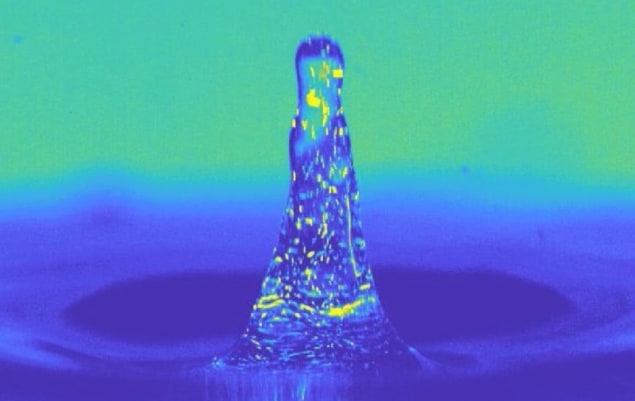
Spectacular upward jets of liquid are produced when a droplet falls on a liquid surface – a phenomenon that has fascinated physicists for at least 100 years. Now, researchers led by Cees van Rijn at the University of Amsterdam have shown that surface tension plays a far larger role than gravity in slowing the upward flow and shaping the jet. The team used advanced imaging techniques to provide a clear quantitative explanation for the self-similar evolution of the jets. Their results shed new light on a widely studied area of fluid dynamics, and could lead to a better understanding of how liquids behave in microgravity.
When a raindrop hits a pool of water, the liquid it contains will rapidly move to fill in the impact crater it forms. This generates an upward-moving jet typically several centimetres in height, which rises and falls in under 100 ms. A key feature of these jets is that their shapes remain the same as they rise and fall – a phenomenon called self-similarity.
The physics of these flows has long been an active area of research, which has largely focused on how various aspects of jet evolution relate to the type of liquids involved. However, the role of one key aspect of small-scale fluid dynamics remains unclear: surface tension is crucial to understanding how droplets in jets evolve but has so far only been invoked to model the droplets that form at the tips of upward-flowing jets.
Fluorescent tracer
De Rijn’s international team explored jets in unprecedented detail using particle imaging velocimetry (PIV). This involves putting fluorescent tracer particles in fluids and illuminating them with a laser – revealing the paths and velocities of the flowing liquid.
The team’s measurements revealed that fluid elements inside the jets decelerated between 5–20 times faster than would be expected from gravity alone. Such high values could only be explained by accounting for surface tension pulling the jets downwards. This insight allowed de Rijn and colleagues to update existing theoretical models to incorporate surface tension alongside the influences of gravity and fluid inertia. Their new models held up for a variety of other liquids, including ethanol, and mixtures of water and glycerol.

Liquid jets bounce along
These improvements allowed the team to better explain the self-similar manner in which the jets evolve. The effect of surface tension means that while the heights and widths of the jets change constantly over time, their velocity profiles and conical shapes show almost no variation. With their updated models, the researchers could match these dynamics with a particular mathematical description of self-similar systems, which they corrected for the contribution from gravity.
The insights gathered by the team provide the first fully accurate quantitative explanations for the shapes and dynamics of the jets produced by impacting droplets. In future research, they hope to repeat their experiments aboard the International Space Station, where the influence of surface tension can be studied in a low-gravity environment.
The study is described in Physical Review Fluids.



